Documentation
In addition to the quick export function of the current view, there are two further options for evaluating and documenting the recorded data:
- Reports can be applied to the current selection (e.g. a query or individual result rows) via the ribbon menu and display the collected data in a graphically clean form.Examples: Client Documentation, User Access Rights, License Portfolio
- Dynamic Documents offer the possibility to create a continuous text (similar to Microsoft Word) in which dynamically selected data from the inventory are integrated.Examples: Emergency Manual, Microsoft Deployment Summary, own evaluations
A large number of reports and dynamic documents are already delivered with LOGINventory. It is possible to adapt these as well as to create new ones. The creation of dynamic documents is easier and more intuitive, since only the desired fields from the database have to be integrated into the document structure via drag & drop.
Both forms of documentation can also be regularly stored in specified locations or sent by e-mail using Tasks.
In addition, all linked files or folders are stored under the Linked Documents node.
Reports
Using Reports
Depending on the currently selected table, different reports are available via the ribbon menu that can be applied to the current selection (e.g. a query or individual result rows). If no report templates exist for a table, none can be applied to the selection.
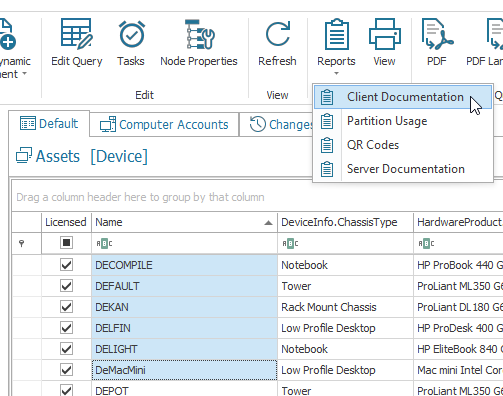
An overview of all available reports can be found in the tree structure in the Reports folder below the Documentation node. When you select a report here, it is applied to all result rows in the table. If the report Client Documentation is selected here, all assets (all entries of the table Device) can be found in the report preview. If, for example, only selected devices are to be included in the Report Client Documentation, you can first either select a query containing the devices or use the Ctrl key to select the devices from the asset list. The report can then be called up via the ribbon menu.
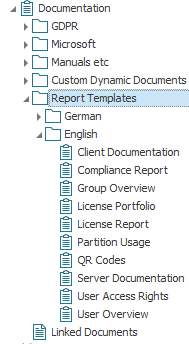
Info
Of course, reports can also be saved in PDF format. In the settings Logos can be stored, these are automatically integrated into the reports.
Supplied Reports
Many useful reports are already delivered with LOGINventory.
Tip
If there are fields in the reports that you are not interested in, or if some fields are missing, you can of course modify the supplied reports at any time by selecting Edit report in the ribbon menu of the respective report. 
Client Documentation
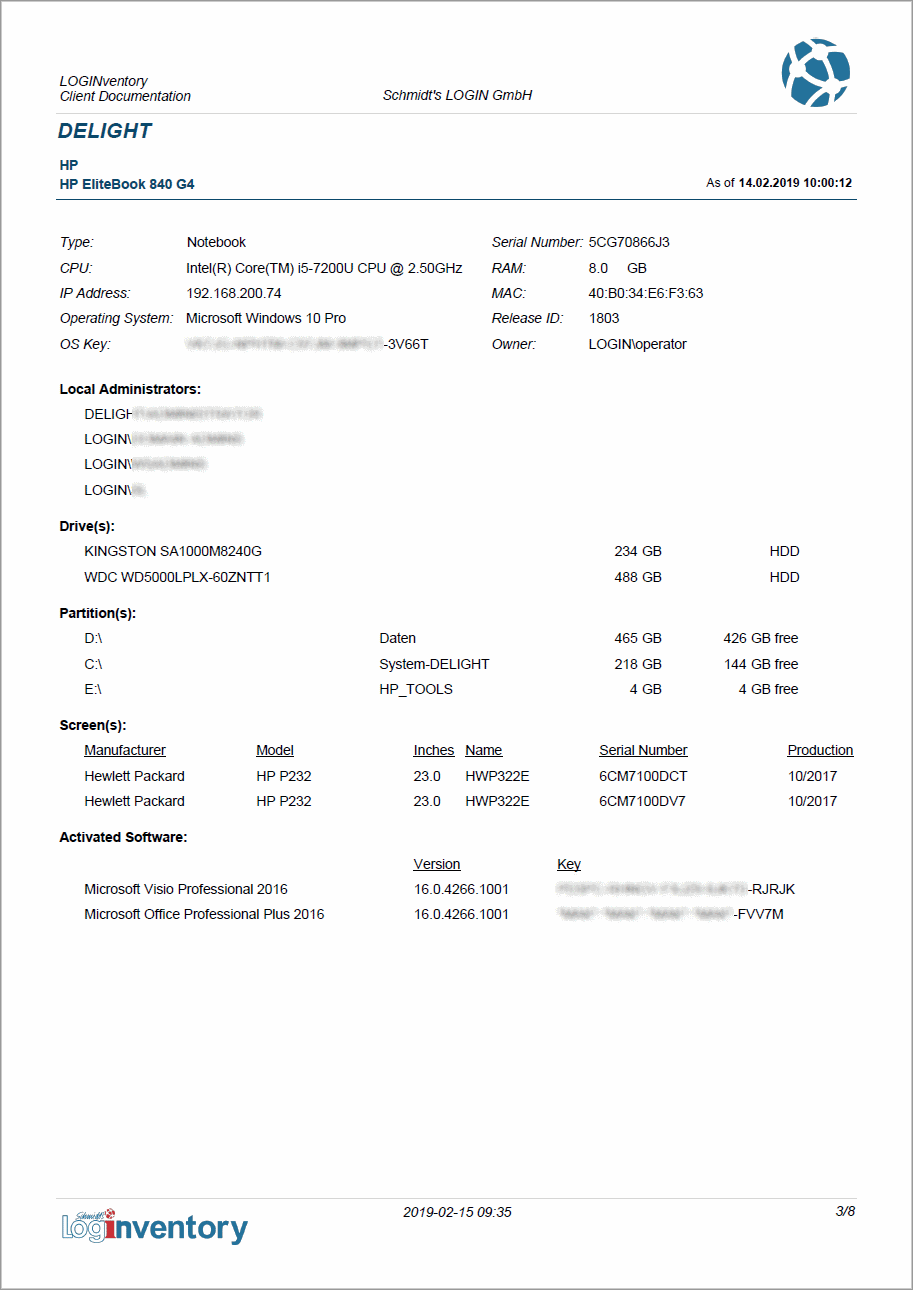
In the client documentation, one DIN A4 page is usually occupied per device. In addition to characteristic hardware and operating system key figures, journal entries, local administrators, installed hard disks, partition allocations, connected monitors and activated software are also listed here.
Server Documentation
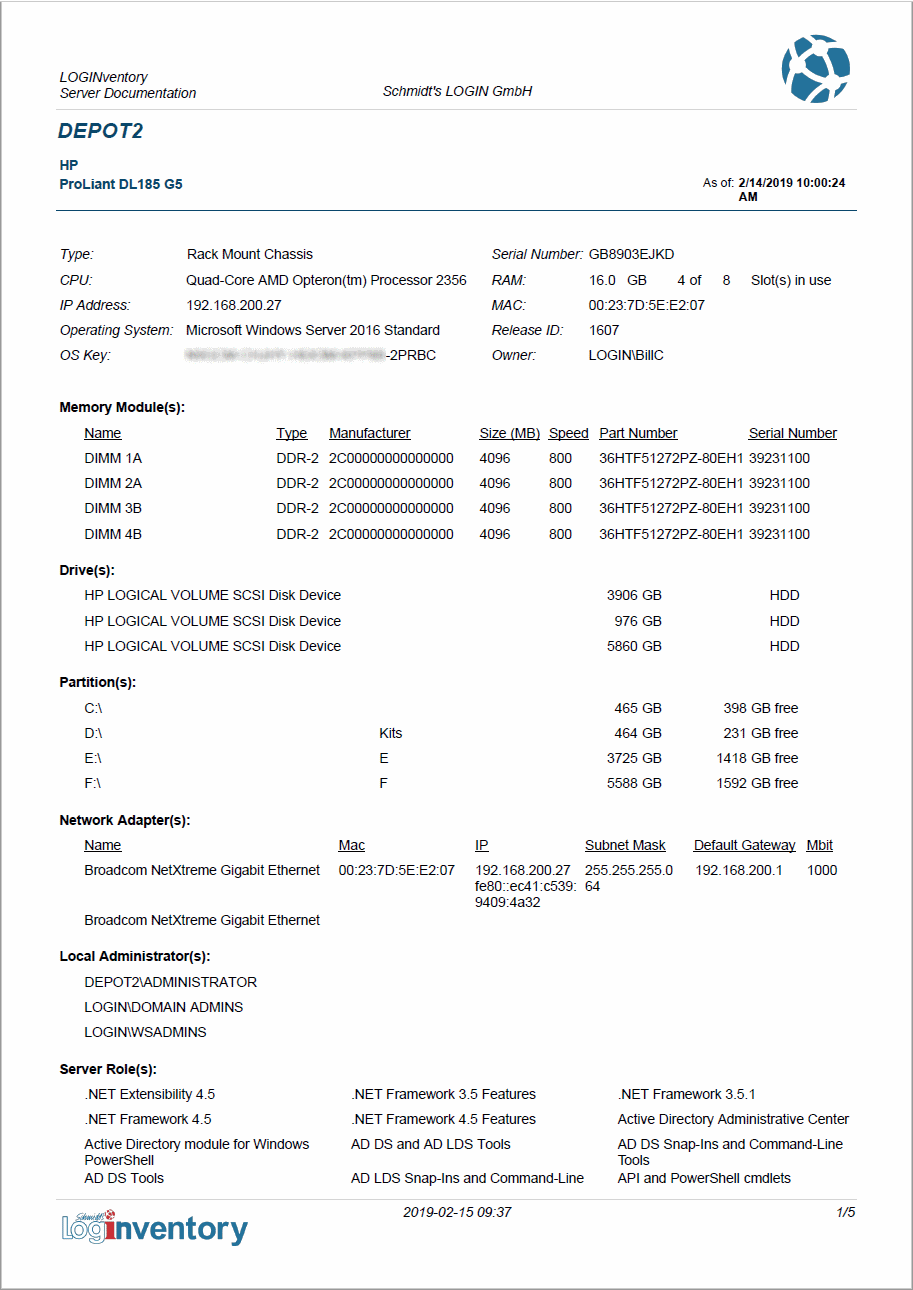
The server documentation is structured similar to the client documentation, but additionally shows built-in memory modules, raid properties, drives, network adapters, server roles, shares and all existing software packages.
Partition Usage

The partition usage report shows the degree of allocation of the existing partitions on the basis of diagrams and thus enables a quick overview of the free storage.
QR Codes
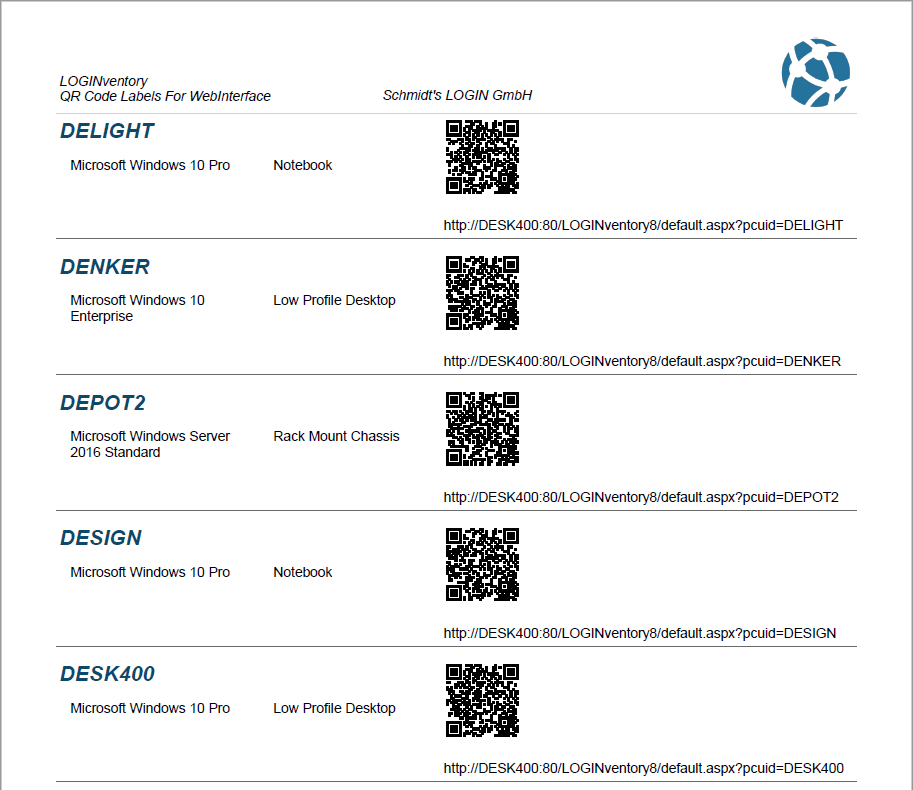
The QR Codes report displays QR codes with a link to the respective device in the web interface. These can be put onto devices and thus enable employees with smartphones or tablets to view the details of the respective device in the Webinterface (if the Webinterface was published.
User Overview
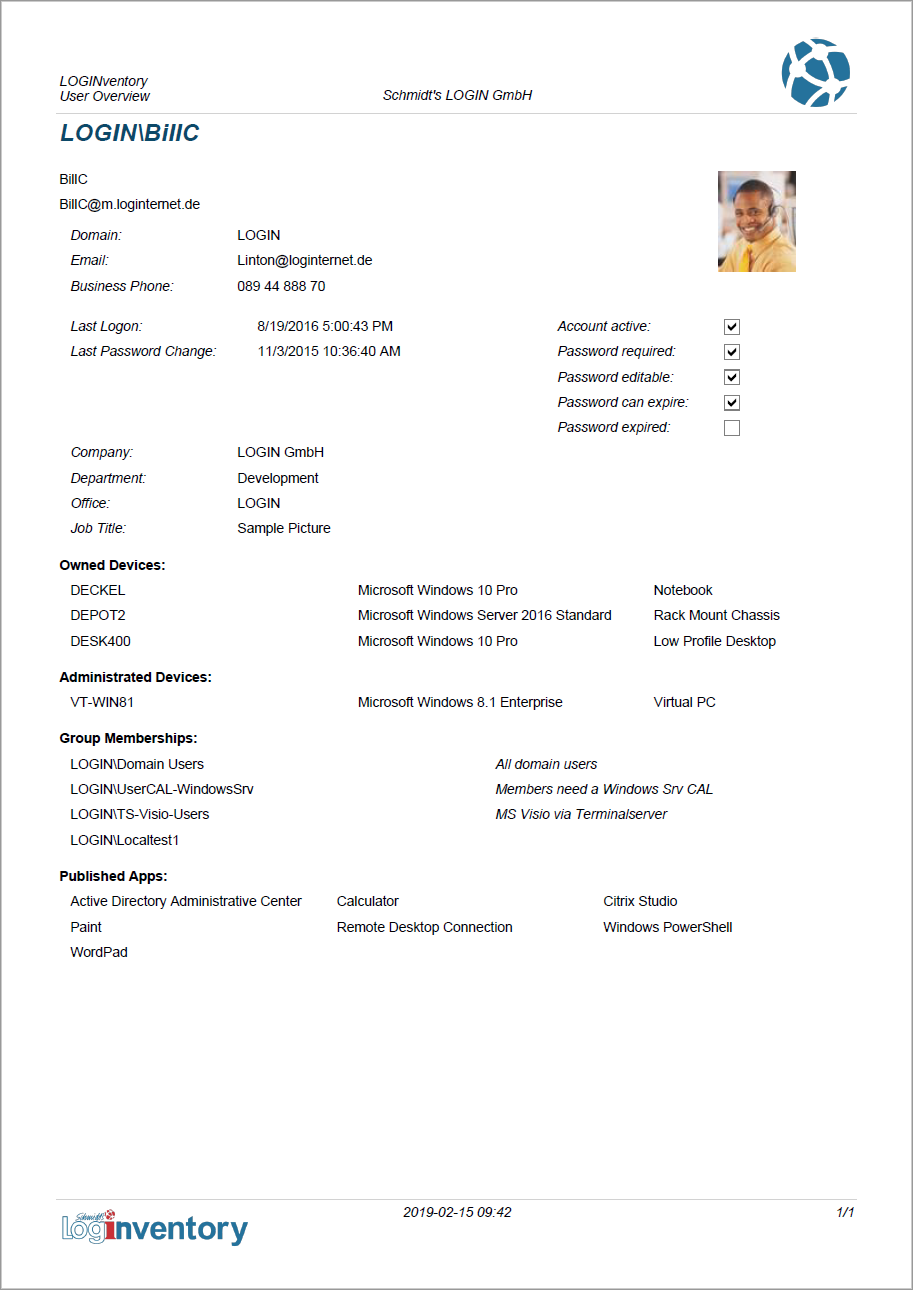
In addition to typical values from the Active Directory, the user overview also displays information about the last logon, password change, etc. Furthermore, all group memberships, published apps, assigned devices, and administrator rights for each user are visible.
User Access Rights
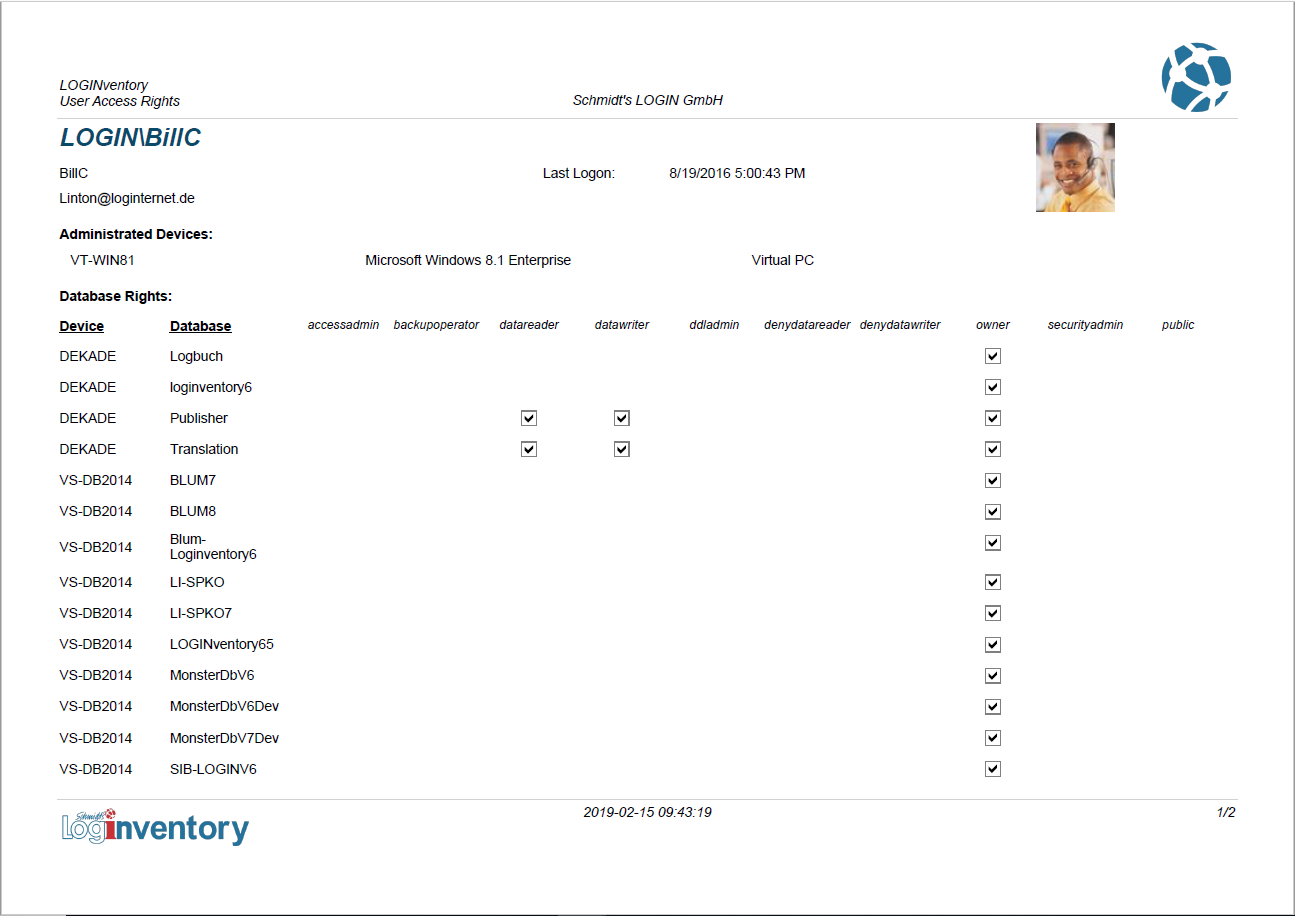
In the user access rights, you can see for each user which SQL databases and shared folders he can access with which type of access right. It also shows on which devices the user has administrator rights. Group memberships have of course been dissolved, so that you can quickly and easily check, for example, if an employee changes department, whether the user really only has the required rights.
Group Overview
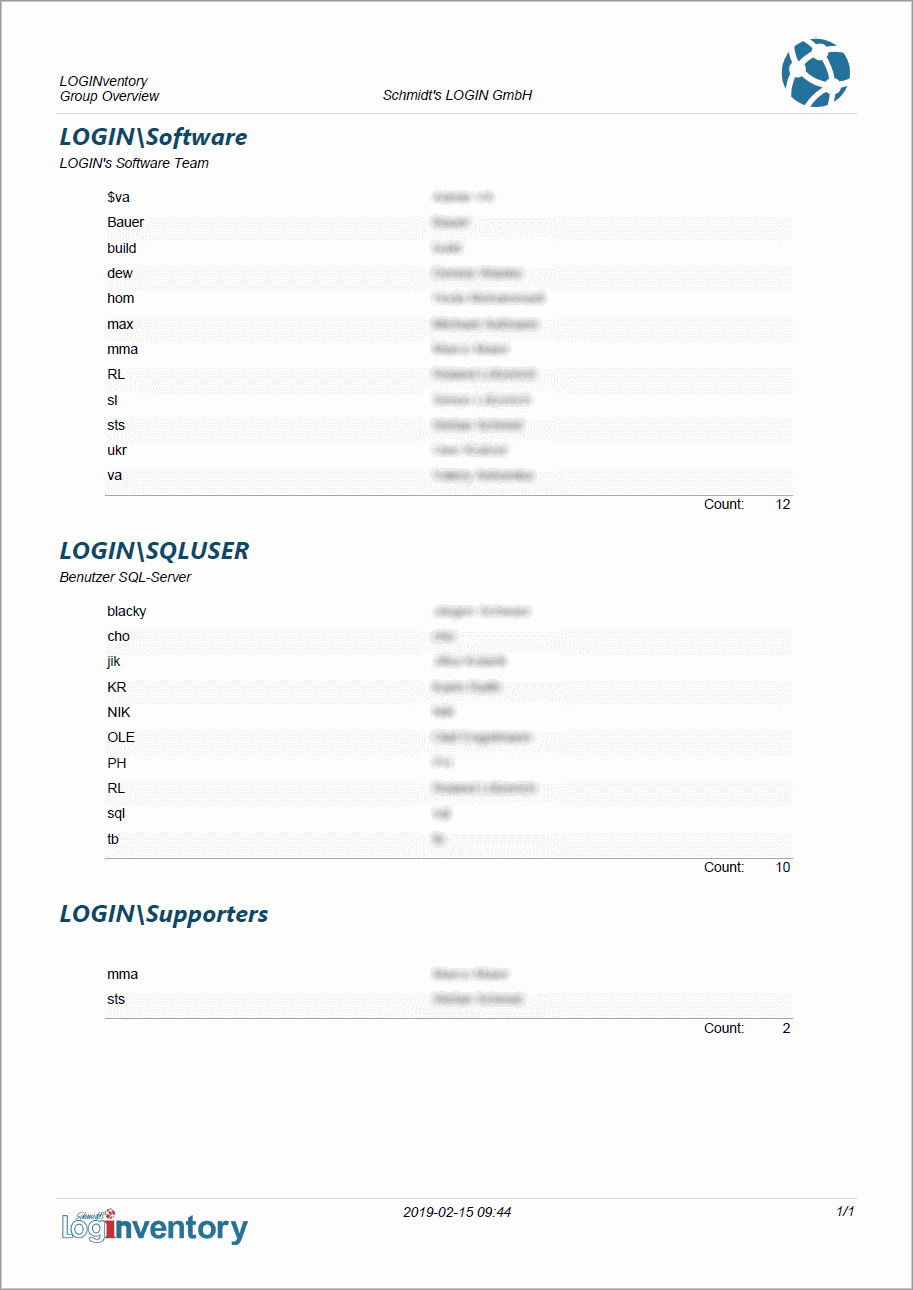
In the group overview all members of each Active Directory group are listed (of course including recursive resolution).
License Report
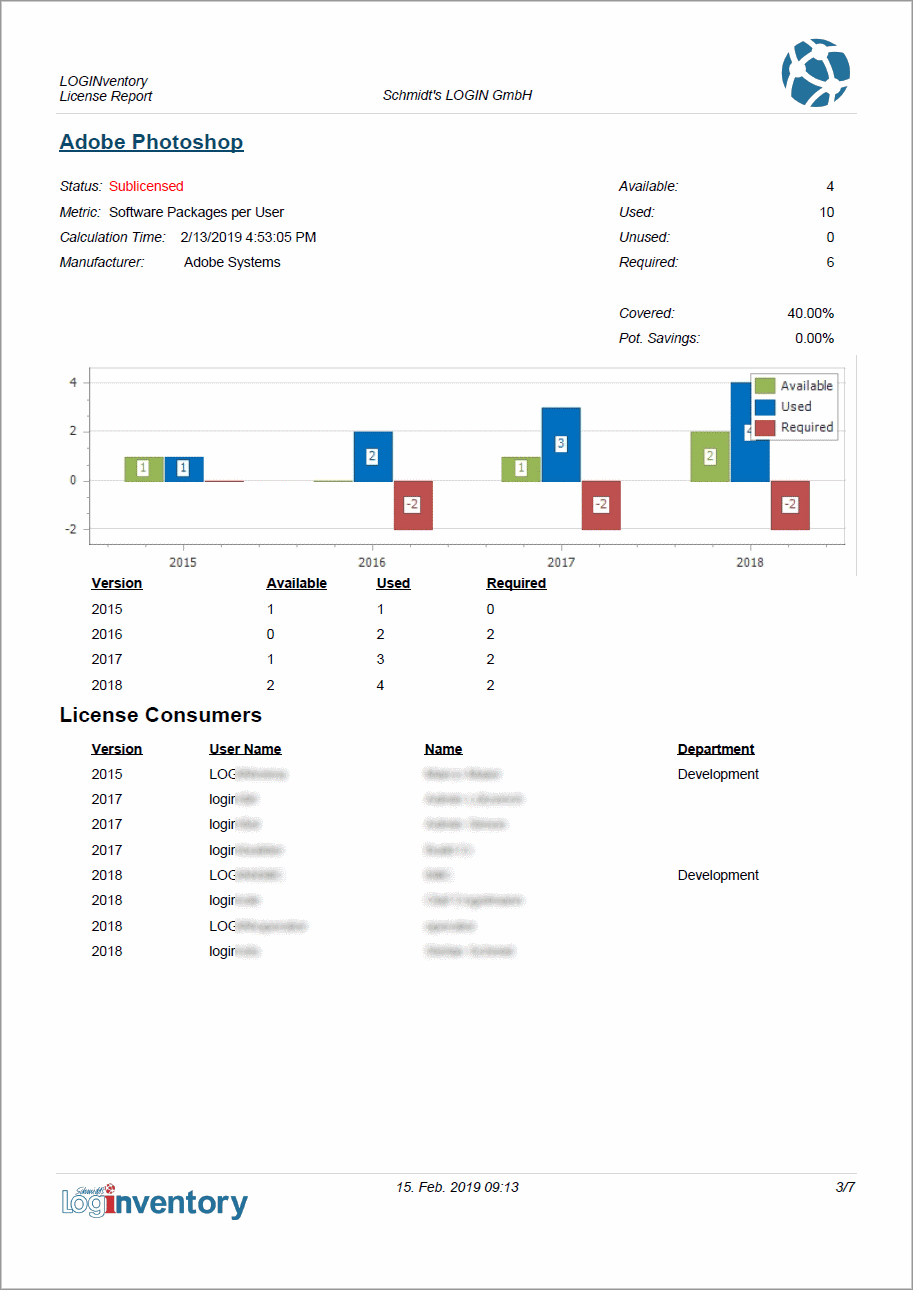
In the license report, the license status, as well as key figures for consumption and availability in the individual versions are displayed in addition to an overall overview. The license consumers are also listed.
License Portfolio
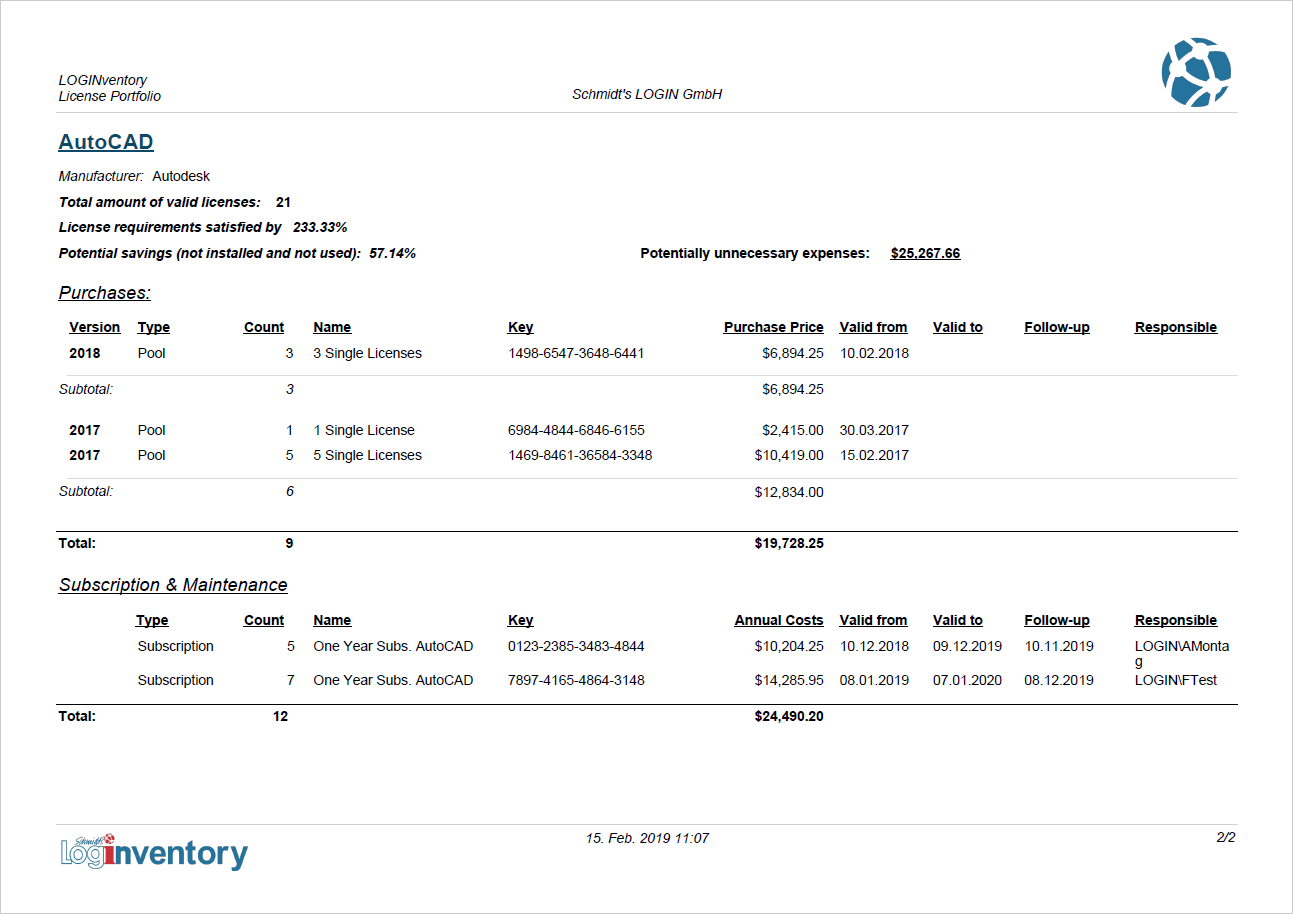
All stored licenses are listed in the License Portfolio report. Relevant values such as license key, validity date, resubmission, person responsible, purchase price and annual price are also displayed. This allows a monetary analysis and the calculation of savings potentials (uninstalled and unused software) to be carried out and it is obvious which costs have to be expected for the next year.
Compliance Report
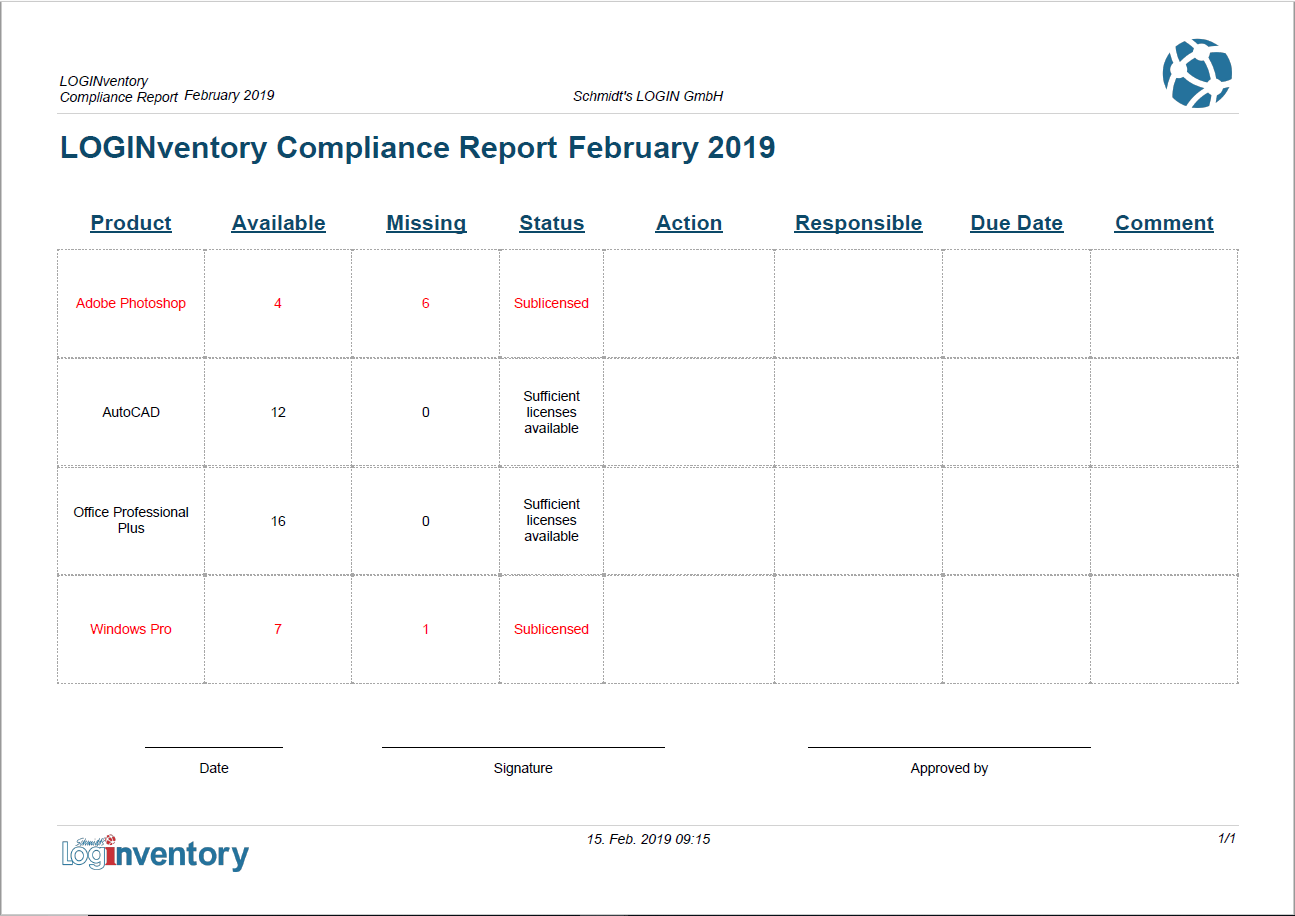
The compliance report lists the current compliance status for each product managed in license management. You can also see how many licenses are available and how many are missing. The user can record in writing which actions are taken to comply with the license terms in the future (e.g. uninstall, buy new licenses, etc.). In addition, responsible persons, due dates and comments can be added. The regular completion of this report is very useful in order to document the compliance efforts of the company, which can be required e.g. in the context of license audits.
Creating Your Own Reports
If you are in the tree structure on the Reports folder, you can select the New / Report function from the ribbon menu. You can then choose the table for which you want to create a report from the dropdown menu. By default, the tables Device, User and SoftwareProduct are available. Normally, these three tables are sufficient for creating reports because they have many links to the other tables. If necessary, you can select more tables via the settings to make them available for reports.
In the report editor itself, you can select the desired fields from the list of fields (right) or from the standard elements (left) text fields and drag and drop them onto the report. Further settings regarding formatting and behavior are possible here.
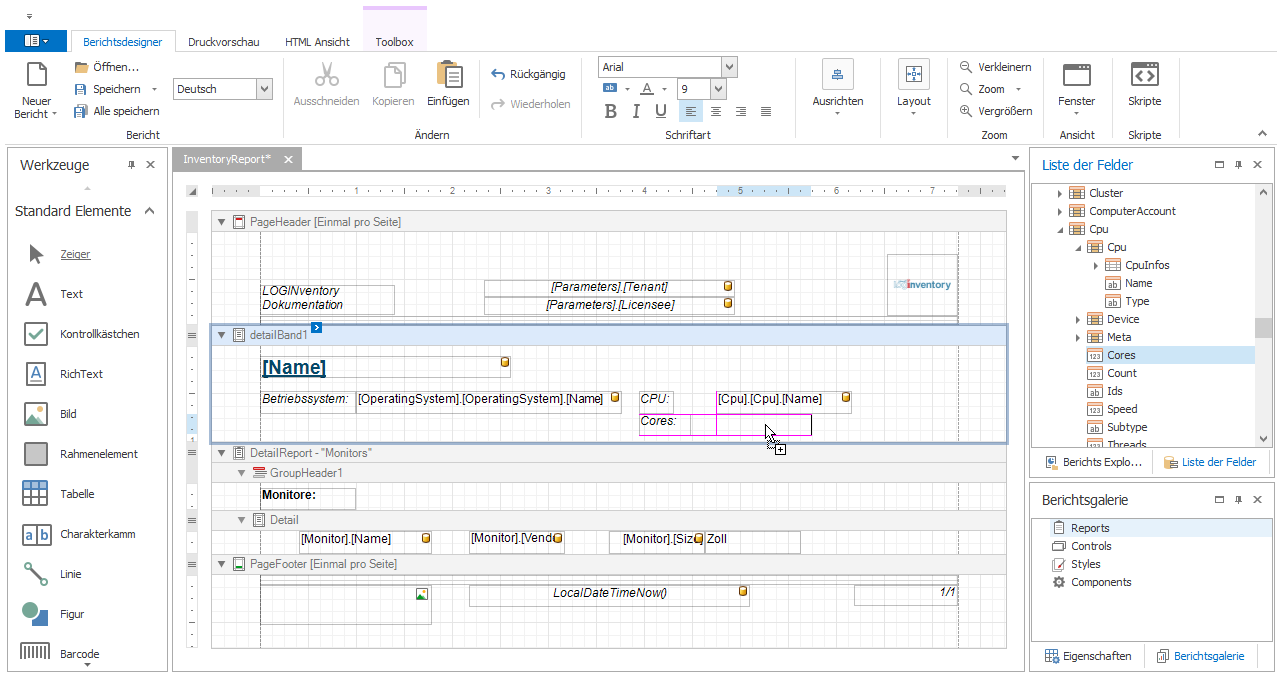
Important
 In general, only 1:1 relations to the selected entity can be inserted into the "detailBand1". For 1:n relations an extra detail report has to be inserted into the report with a right click. 1:1 relationships are indicated by the icon with the yellow center bar, whereas 1:n relationships have a white center bar in the icon.
In general, only 1:1 relations to the selected entity can be inserted into the "detailBand1". For 1:n relations an extra detail report has to be inserted into the report with a right click. 1:1 relationships are indicated by the icon with the yellow center bar, whereas 1:n relationships have a white center bar in the icon.
Example
For each device there is exactly one CPU type (1:1 relationship), therefore information about the CPU can be directly integrated into the "detailBand". Several monitors can be connected to one computer, so an extra detail report is required for the monitors.
Info
The detailed documentation of the report editor can be found here.
All new reports refer to the Basic Report Template. If the template is adapted, all new reports are also adapted accordingly.
Selecting a report language ensures that this report is only displayed in the ribbon menu for the report language defined in the settings.
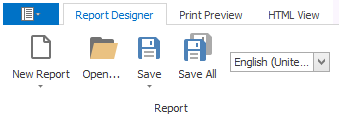
Info
Self-created reports are only offered in the ribbon menu for the respective entity if they have been positioned in the tree structure in the folder "Report Templates" or a folder below it.
Deactivating a report means that it is not available in the ribbon menu and therefore cannot be applied.

Dynamic Documents
Using Dynamic Documents
Dynamic documents are suitable for embedding the current data from the inventory in a continuous text structure. They are also suitable for quickly and easily integrating selected columns into a report and applying functions to these results (e.g. counting entries). This means that they can also perform a similar function as Own Queries, but often present the results in a more graphically appealing form.
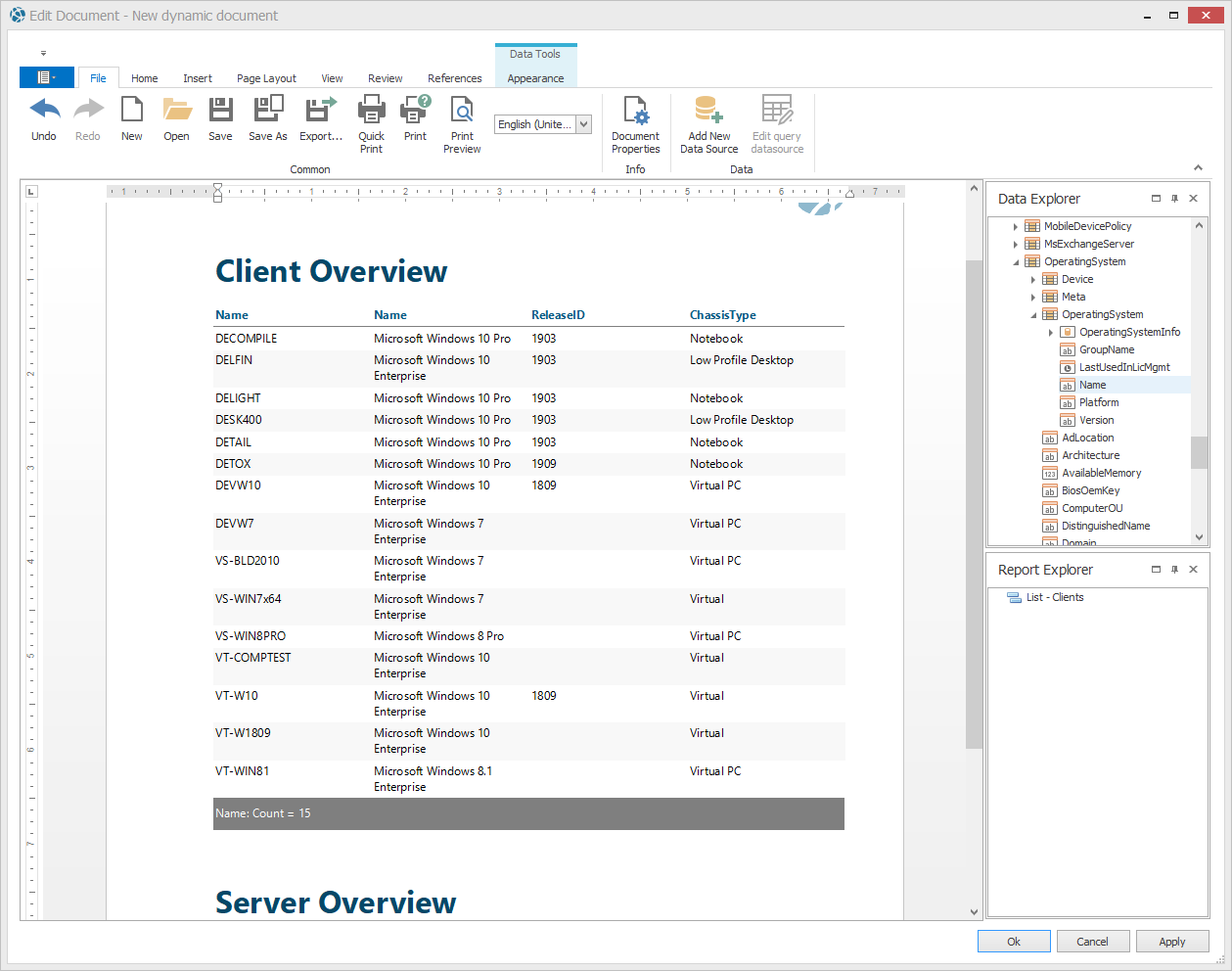
Some Dynamic Documents are already delivered in the tree structure in the Dynamic Documents folder below the Documentation folder. In contrast to reports, these documents are not applied to a selection of elements, but always refer to the query above them. If the document is not below a query, the result set is not restricted.
Supplied Dynamic Documents
All provided dynamic documents can be adapted naturally. The documents cannot be accessed via the ribbon menu, but can be found under the "Documentation" node. Tasks can also be positioned on the documents so that they are automatically filed or sent, for example.
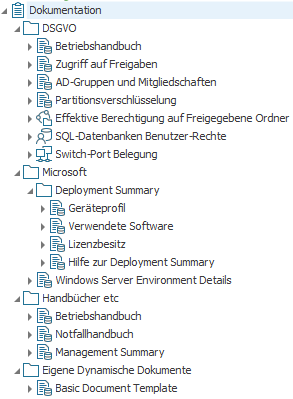
Management Summary
The Management Summary lists the most important hardware inventory (desktops, laptops, Macs, physical servers). It also provides an overview of all virtual machines and on which hosts they are running.

Operating Manual
The Operation Manual shows which hosts exist and which virtual machines are running on them. The server roles are also listed so that it is immediately clear which domain controllers, DNS servers, etc. exist. Depending on the application, it is possible to add further data here.
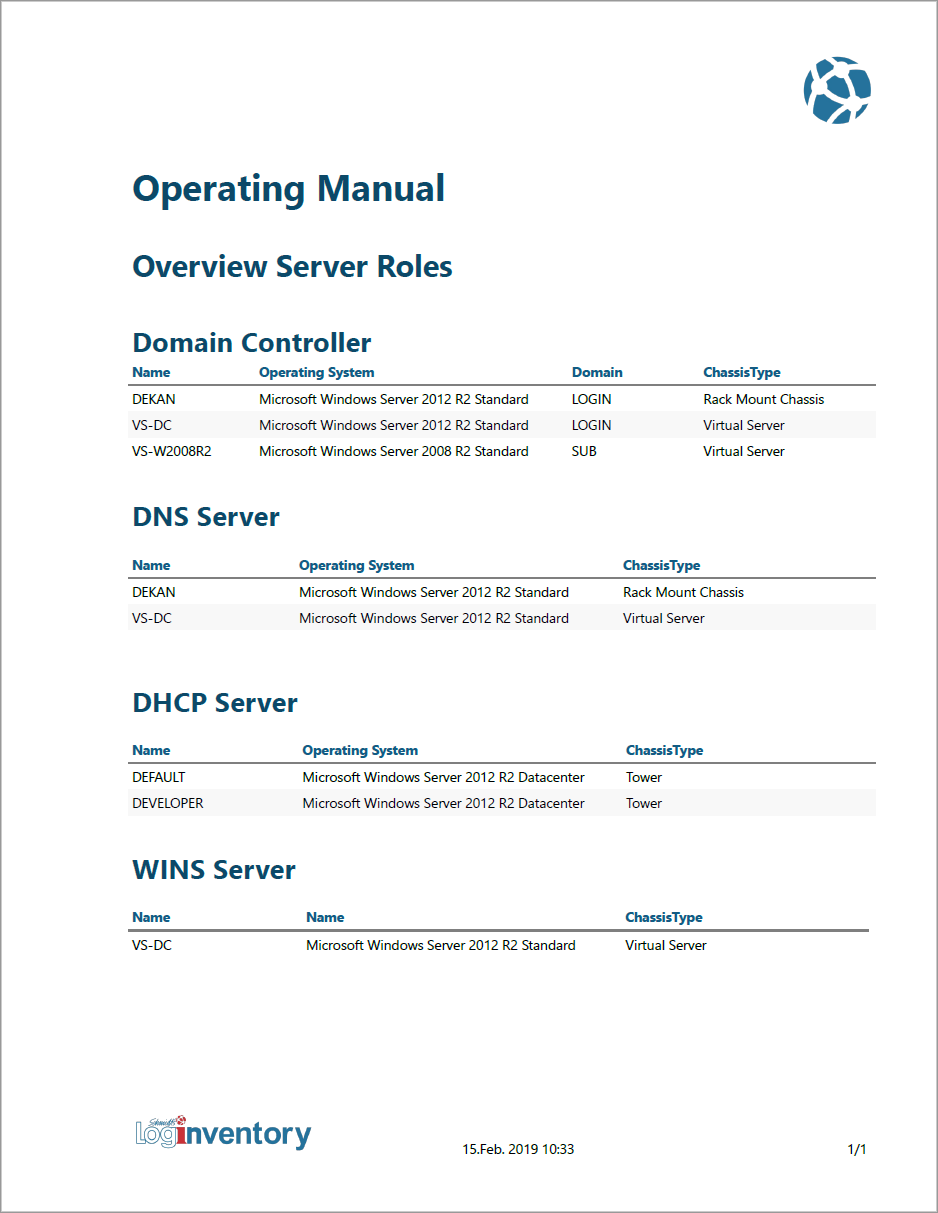
Microsoft Deployment Summary
The Microsoft Deployment Summary is often required by Microsoft at the beginning of a license plausibility check. For this purpose, Microsoft must be informed of which devices are present in the company (Device Profile), and which software is used how frequently (Software Currently Installed). Proof is also required of the licences used (Licenses Held).
The supplied documents provide you with exactly the numbers you need, so that they are available at the touch of a button and no longer have to be collected laboriously.
Device Profile:
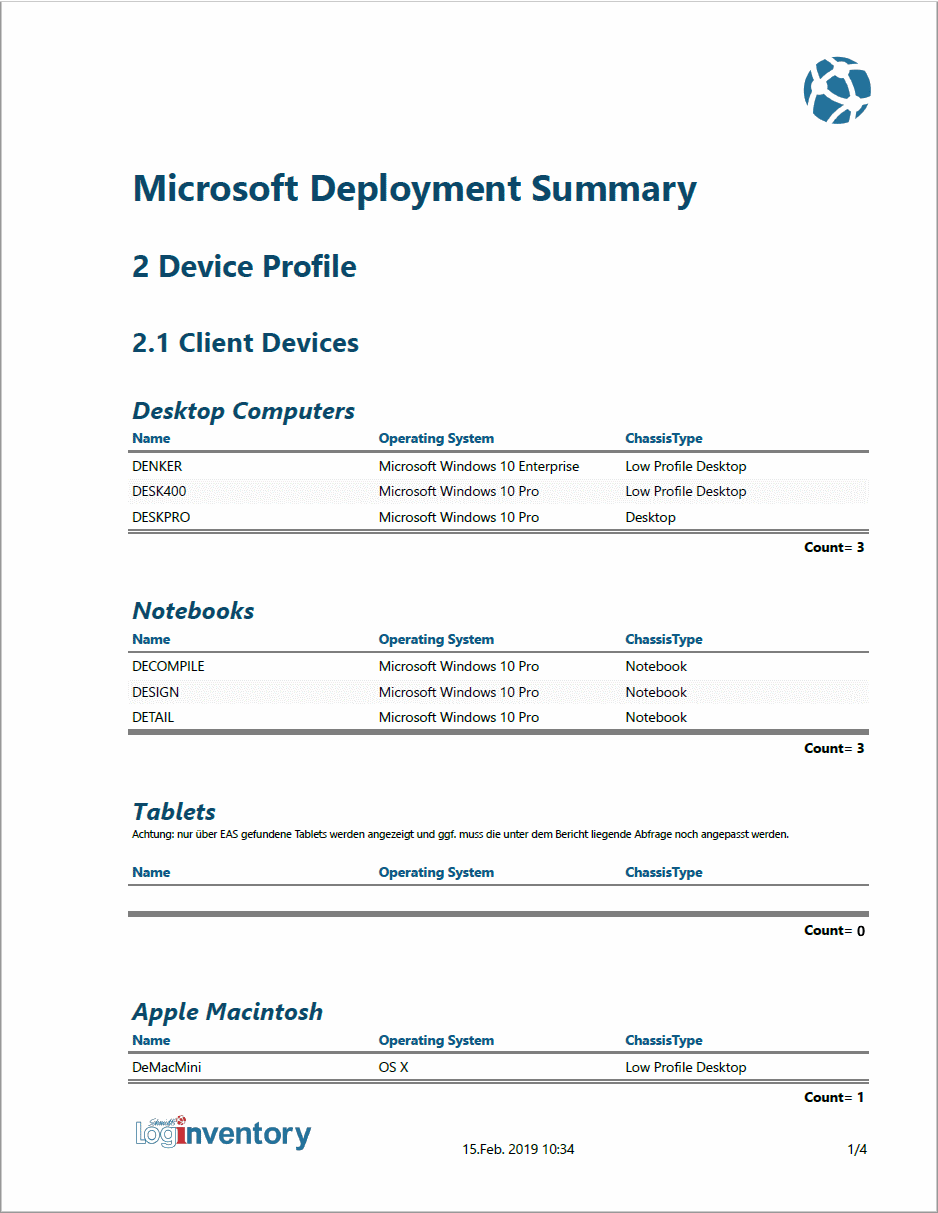
Software Currently Installed:
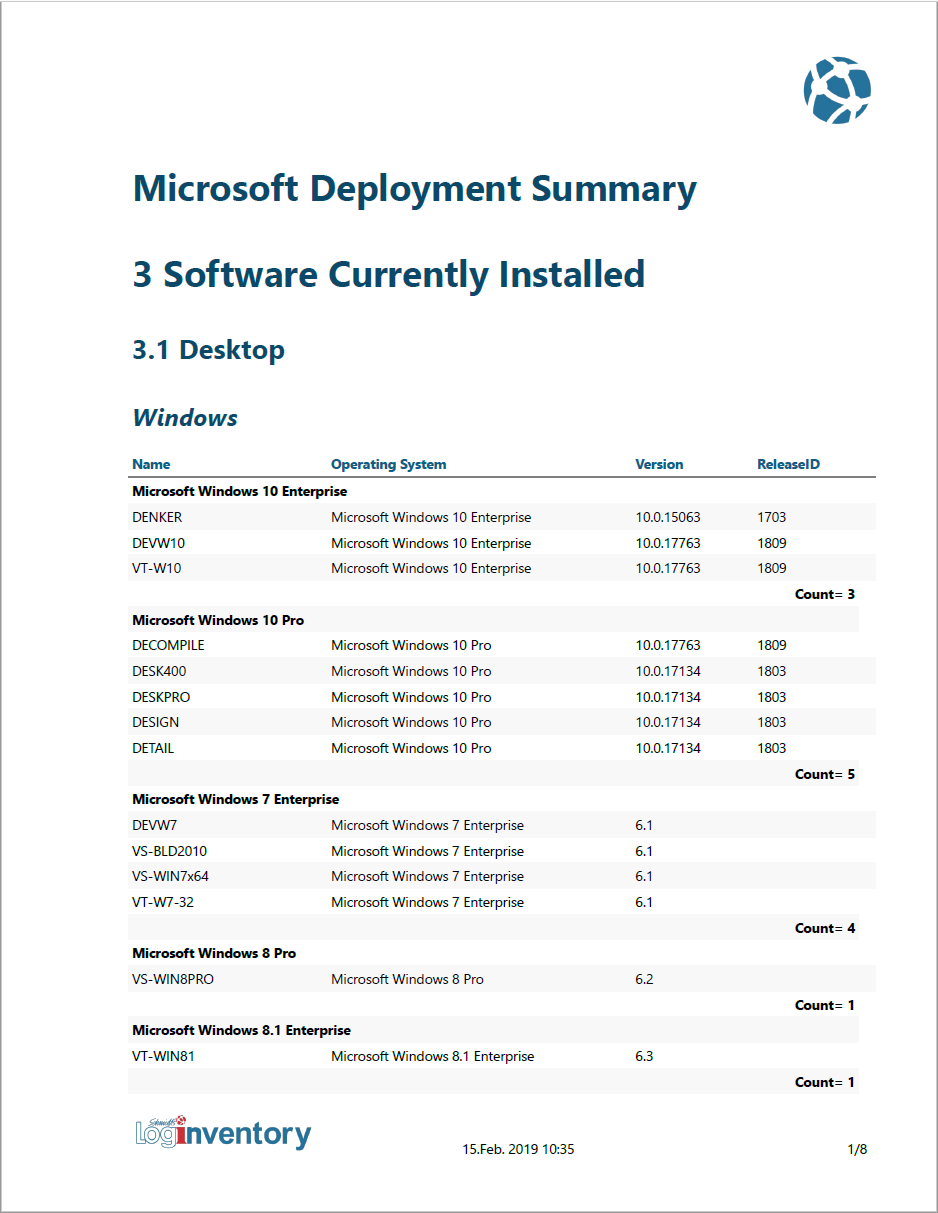
License Held:
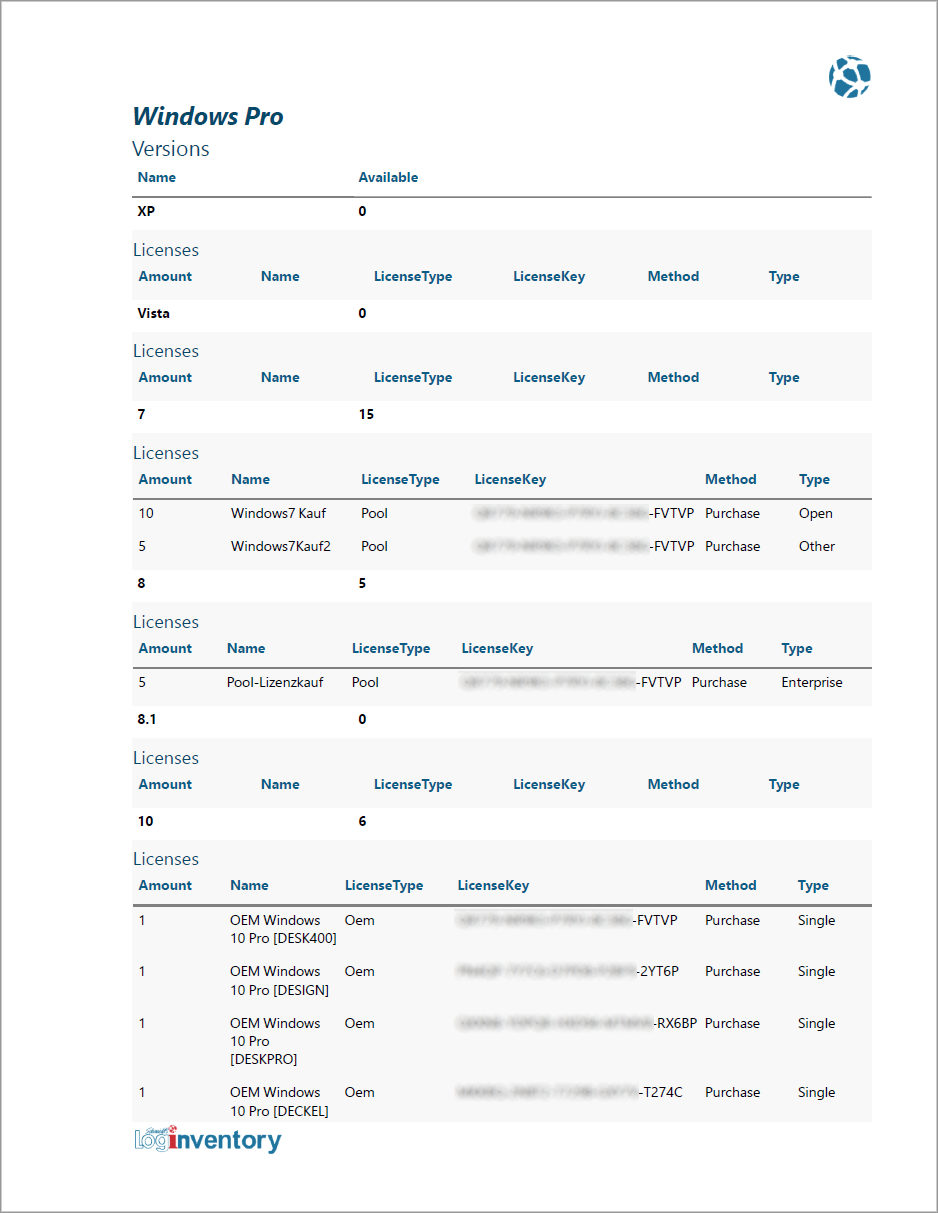
Windows Server Environment Details
Similar to the Deployment Summary, the Windows Server Environment details show which hosts are configured how and how many virtual machines are running with which operating system on which host. This data can also be requested by Microsoft as part of an audit.
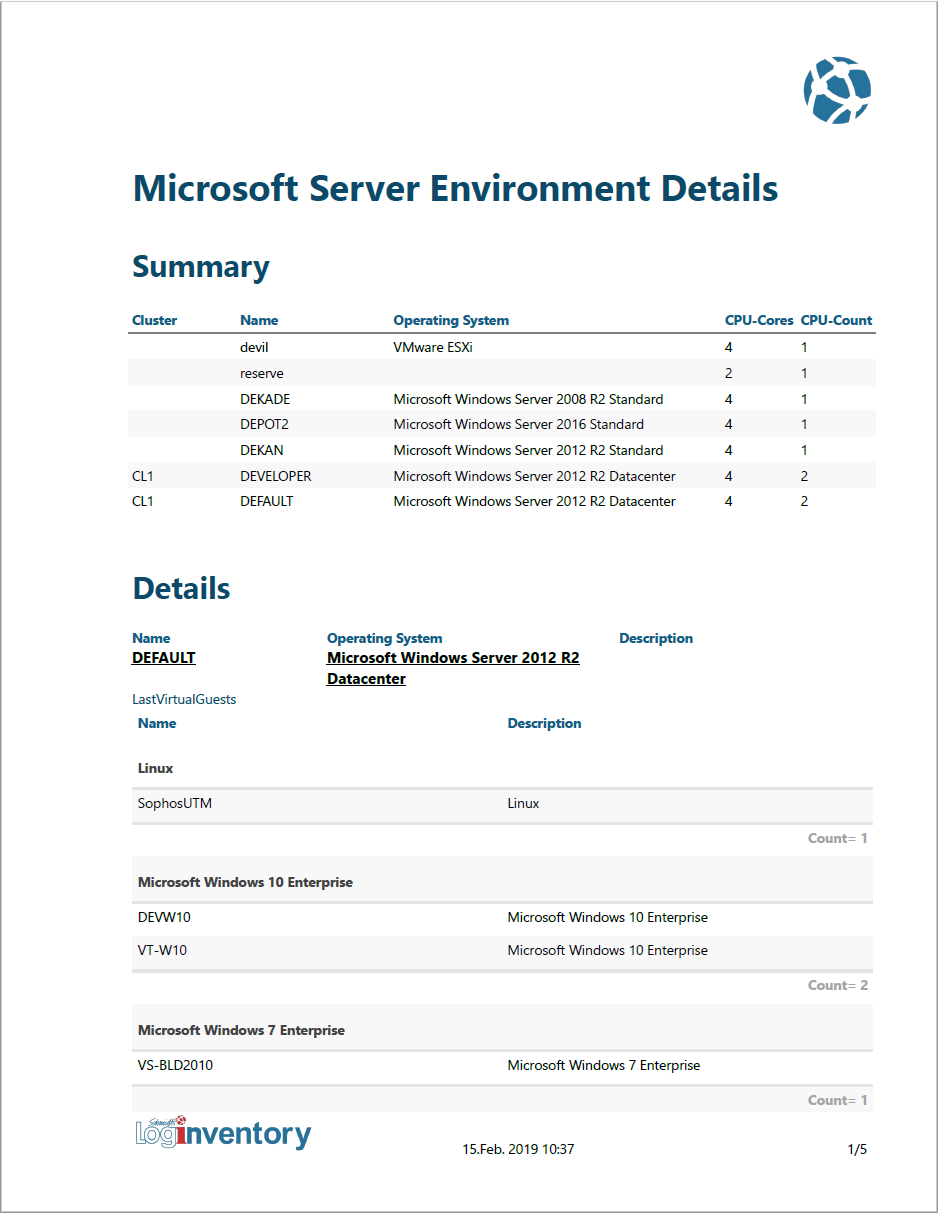
Creating Your Own Dynamic Documents
Dynamic documents can be created anywhere in the tree structure using the ribbon menu. From the dropdown menu, select the table for which you want to create a Dynamic Document. By default, the tables Device, User and SoftwareProduct are available. Normally, these three tables are sufficient for creating reports because they have many links to the other tables. If necessary, you can select more tables via the settings to make them available for reports.
The selected table is then available as a data source in the document. If the document is positioned below a query, the filter conditions of the query restrict the result set in the document.
Example
The columns Device.Name and Operatingsystem.Operatingssystem.Name are integrated in a new Dynamic Document for the table "Device". If the document is not below a query (e.g. in the Dynamic Documents folder), there are no filter conditions above it. The computer name and operating system name of each device are listed. If the document is now positioned below a query with filter conditions (e.g. Platforms / Windows Clients), only the computer and operating system names of all Windows clients are listed in the document.
If further data sources are required, more data sources can be added within the document.

For this purpose, you can either
- select an existing query from the tree structure,
- create a new query,
- or select an SQL database as an external data source.
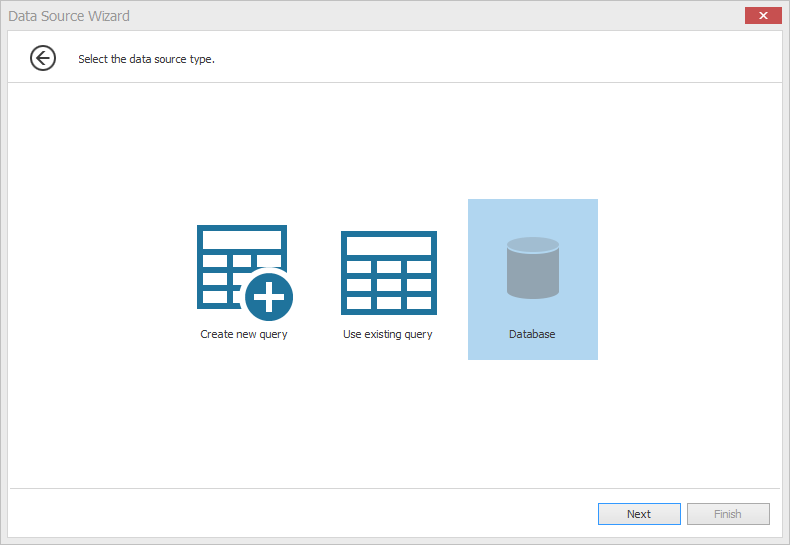
Tip
If you have external data in an SQL database you can also query this data and include it into Dynamic Documents: 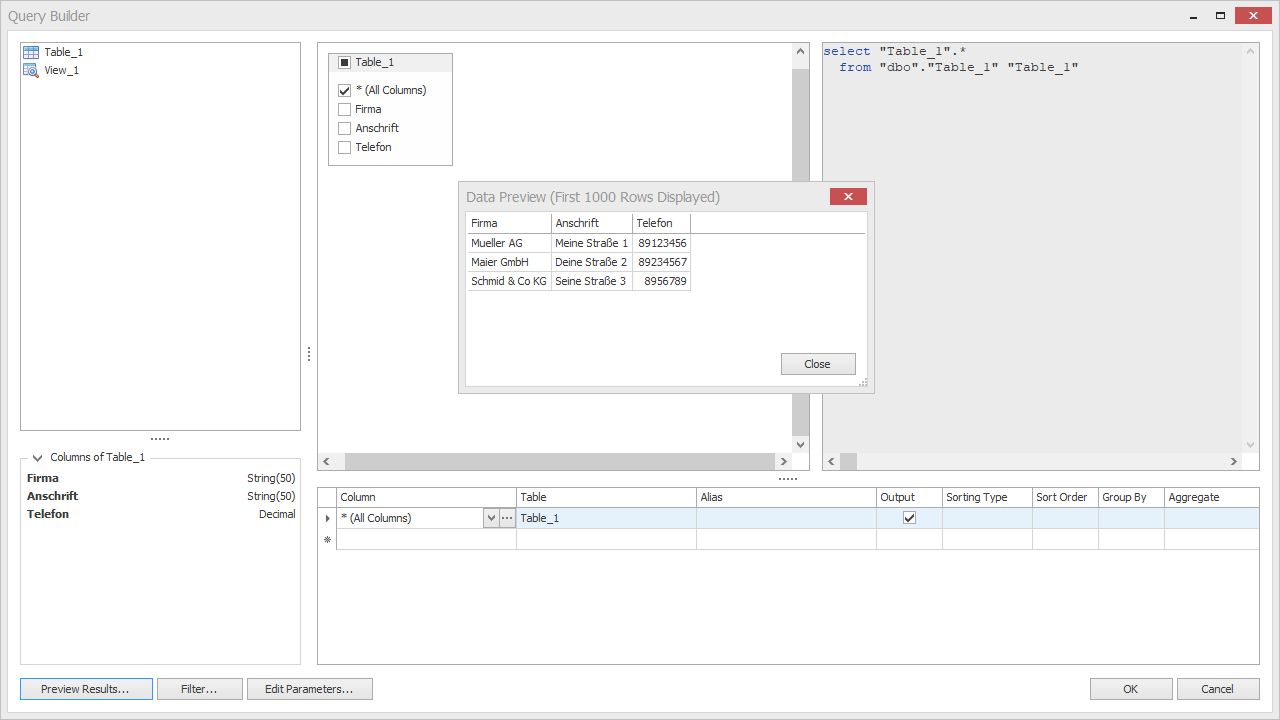
These are then available as data sources in the document on the right-hand side.
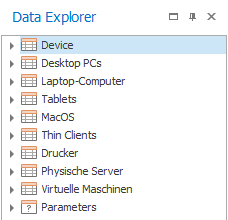
Note
Please note when using (newly created or existing) queries: The selection of columns does not matter, as all available columns in the document can be selected anyway. Only the selection of the base table (e.g. for devices "Device") and the set filter conditions are considered. 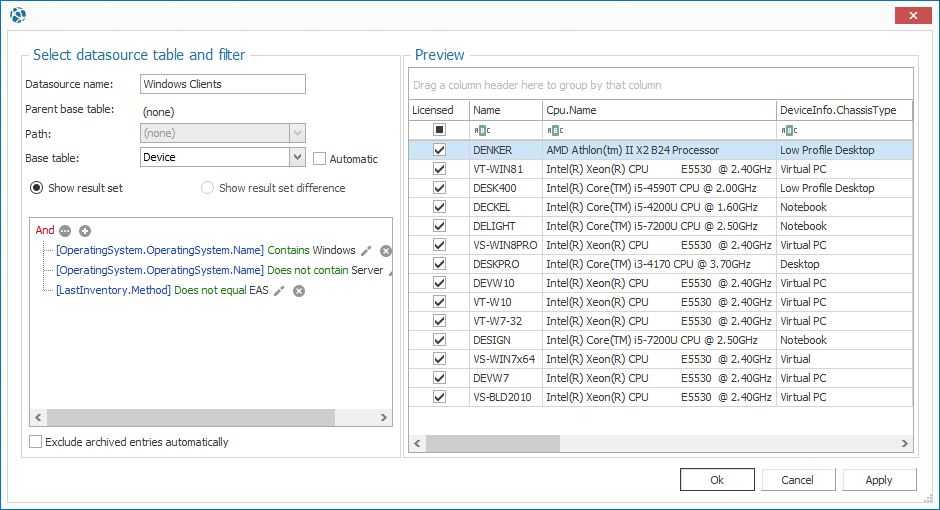
To edit an existing document, Edit Document can be selected from the ribbon menu. Similar to Microsoft Word you can use the different tabs to
- adjust the formatting,
- drag and drop data fields onto the document,
- integrate the name of the document node from the tree structure as parameter "Title" into the document,
- create tables
- apply sorting, grouping & calculation functions.
The following should be considered when adding data fields:
- All desired fields can be selected with the Ctrl key and then dragged together onto the document. The field names are then created as column titles and the corresponding values are displayed below.
- Only 1:1 relationships can be displayed next to each other in columns (e.g. Device.Name, Cpu.Name, Operatingsystem.Name, etc.).
- If additional 1:1 relationships are to be integrated into a table, they can be dragged to the right edge of the table until a light blue vertical line is visible.
- If 1:n relationships are to be integrated, they can be positioned below a 1:1 relationship if a vertical light blue line is visible using drag & drop.
- If you hold down the Shift key while dragging, the table is inverted; the names of the values are in the first column, the actual values in the second column.
- By default, only the first 20 columns are displayed in the document editor. However, this value can be increased in the "List" ribbon. In the final document, of course, all lines are always present.
All new documents refer to the Basic Document Template. If the template is adapted, all new documents are also adapted accordingly. You cannot add data sources to this document!
Linked Documents
In the node linked documents all stored files and folders are listed, which have been stored via the widget Documents or via the ribbon menu to assets, queries and folders. This allows you to see, for example, where the same document was stored or which links have follow-up data (FollowUp).
Info
Of course, you can also create your own queries for the ExternalResource table. This also allows tasks and notifications to be set to documents with a specific resubmission date, for example to remind you by email that a device's warranty is about to expire.